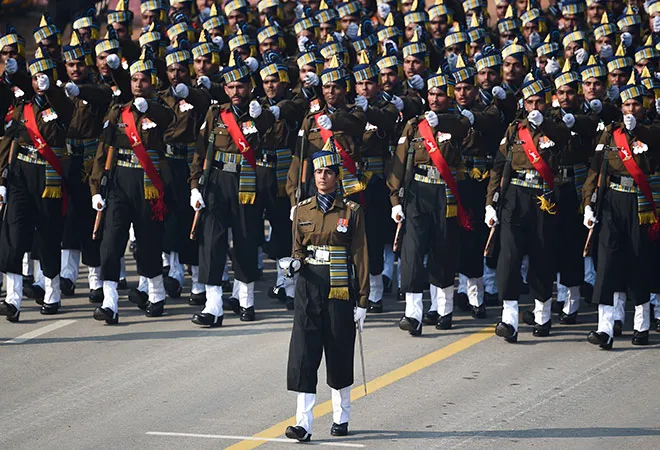
India’s Union Budget 2020-2021 has seen ₹4,71,378 crores (US$ 63.7 billion) being allocated to the Ministry of Defence (MoD), an increase of 8.5% from last year’s budget estimates. A majority of this increase, however, has gone towards the payment of pensions, salaries and allowances. In fact, a massive 28% of MoD’s total budget this year was earmarked for pensions, and another weighty chunk of 28.6% for salaries and allowances. Hence, with more than half of the pie already accounted for, the country’s budget continuing to remain finite, and the ongoing COVID-19 pandemic straining the treasury ever more, it seems inevitable that India’s need and vision for military modernisation will not be able to travel far down this road.
Against this backdrop, the Department of Military Affairs (DMA), headed by Chief of Defence Staff (CDS) General Bipin Rawat as its Secretary, has recently come out with a proposal that spells out three changes. First is a rank-wise increase in the retirement ages of officers up to the rank of Major General and equivalent of the tri-services, less those in the Army Medical Corps and the Military Nursing Service. Second is an increase in the retirement ages of Junior Commissioned Officers (JCOs), Other Ranks (ORs) and equivalent in Logistics, Technical and Medical Branches, including the Corps of Electronics and Mechanical Engineers (EME), Army Service Corps (ASC), and Army Ordnance Corps (AOC). The final element is a revision in pension entitlements for those seeking Pre-Mature Release (PMR) from the Services after serving the pensionable age, with personnel having to don the uniform for more than 35 years to be entitled to their full pension, i.e. 50% of their last drawn salary.
The proposal ostensibly seeks to increase retention of trained personnel, noting that “there are several specialists/super-specialists who are trained for high skill jobs in the services that leave the service to work in other sectors. Such loss of high skilled manpower, results in void in the Services skill matrix and is counter-productive to the Armed Forces.” Therefore, by increasing the retirement ages of officers and JCOs/ORs with technical expertise, those currently serving would be retained for longer without turnover. The proposed change in pension entitlements is seen as a way to nudge individuals to stay on instead of seeking employment in other sectors after taking PMR.
The proposal ostensibly seeks to increase retention of trained personnel, noting that “there are several specialists/super-specialists who are trained for high skill jobs in the services that leave the service to work in other sectors
The bigger aim, though, is clearly a reduction in pension expenditure. Delaying the payment of pensions as proposed would reduce the size of new pension liabilities, and as a result, overall pension expenditure will lessen. Having individuals serve longer would also save costs on training their successors at more frequent intervals, and negate the dual burden of paying both pensions to those retiring at a relatively young age and salaries to those who replace them.
Beyond the ethical questions around abruptly and drastically changing the terms of service and pension, the most obvious challenge to the proposal is that these changes are outside the DMA’s jurisdiction. Referring to GoI (Allocation of Business) Rules, 1961 in which DMA’s responsibilities were codified, this criticism is valid, since altering the terms of employment and pension structure does not appear in the list. Even so, the CDS himself has come out in support of his department’s proposals, expressing them to be aimed at enhancing “the well-being of the competent frontline soldiers who face the real hardships and on whose courage and valour, we all seem to be basking in glory.”
The DMA proposal will also skew the average age of the military. As a serving officer pointed out, “the whole idea is to keep the force young.” Others have noted that measures taken over the years to keep the forces “young and fighting fit” would be undermined. Implementing these proposals would also mean that those on top of the steep pyramidical hierarchy of the Services would continue to fill their present posts for longer and thereby promotions throughout the ranks would be stalled. This in turn would only exacerbate the already fraught situation wherein officers who are not up for promotions would have to keep serving at their current ranks for a longer time if they want to qualify for the entirety of their pension. Recruitment and retention at lower ranks are all but guaranteed to suffer – many will question why they should bother serving 20 or more years for half the pension.
If decreasing overall manpower costs is the aim, a more straightforward approach would be to gradually reduce the base, i.e. the number of individuals on direct payroll and those eligible for future pensions. Outsourcing, for instance, has outsize benefits against both pay and pension liabilities. By sub-contracting non-critical tasks such as transportation of goods and other logistics in non-sensitive areas, and maintenance and repair of equipment, the Services would not have to maintain large, specialised cadres to cater to these needs. The Indian Navy has already had some experience with outsourcing, using this route for operational requirements like ship refit and overhaul, engineering, technical support, IT, dredging and so on. There is no net drop in employment, the same ends are met on the ‘tail’ end of the ‘tooth-to-tail’ ratio, salary and training liabilities will stay constant (if not reduce), and pensions are eliminated altogether.
If decreasing overall manpower costs is the aim, a more straightforward approach would be to gradually reduce the base, i.e. the number of individuals on direct payroll and those eligible for future pensions
Another option that could be pursued separately or in tandem is an overhaul of the Short Service system to include more personnel under arms – particularly Other Ranks – with contributory retirement benefits for this stream, perhaps under the National Pension Scheme (NPS) or a similar bespoke setup for the military. A truly ‘short’ service period of five, seven or ten years, would allow manpower to be released at ages where they are still able to seek gainful employment, with the added benefit of a modest contributory pension or larger gratuity at release. Making the Short Service system more attractive overall will allow the military, particularly the manpower-heavy Army, to solve the largest part of its manpower problem.
In the current geo-political scenario, it is vital that funds allocated toward military modernisation increase, but it is equally important that proposals to do so be grounded in reality, account for second and third order effects, and prioritise the long-term health and welfare of the backbone of the military – its people.
The views expressed above belong to the author(s). ORF research and analyses now available on Telegram! Click here to access our curated content — blogs, longforms and interviews.




 PREV
PREV



